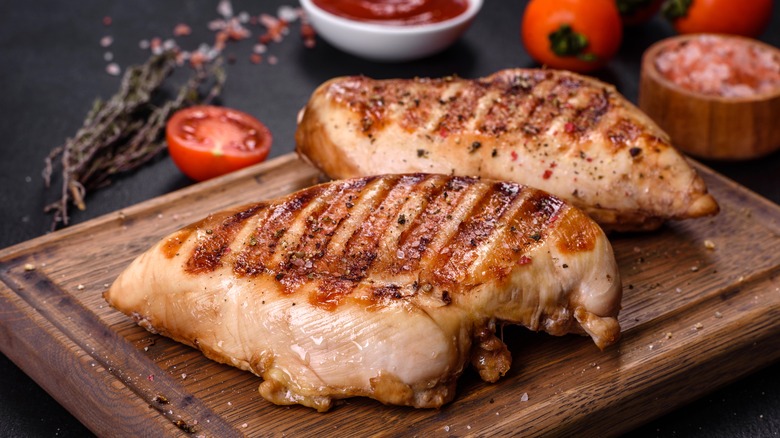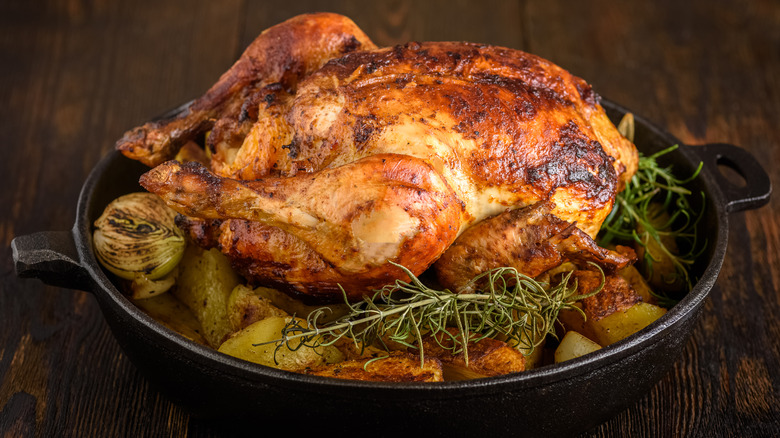How To Tell When Chicken Is Cooked Inside, According To Giada De Laurentiis
Whether roasted, grilled, or pan-fried, chicken always makes a comforting crowd-pleaser of a dinner. Unlike with steak, poultry absolutely has to be cooked through before serving. According to USDA guidelines, chicken, whether whole, minced, or in pieces, should always be cooked to an internal temperature of at least 165 degrees Fahrenheit. Then, like steak, it should be rested, so the juices can redistribute, and the meat is more moist and tender.
While chicken requires careful cooking to make sure it's fully done, there's also a risk that it can become overcooked and dry, especially with leaner cuts like skinless, boneless breasts. The absolute best method to check if it's cooked to a safe temperature is to use a meat thermometer to accurately measure when it's ready. But if you don't happen to have a thermometer to hand, Giada De Laurentiis has an alternative technique, which involves touch.
@giadadelaurentiis One of my most requested recipes: Chicken Piccata Recipe on @Giadzy #chickenpiccata #chicken #italianchicken #giada #giadadelaurentiis #giadzy #bestchicken #chickenrecipe
By pressing down with her finger on her piece of chicken as it cooks in a skillet, the Italian chef and TV personality checks to see how firm the texture of the meat is, as demonstrated on TikTok. The chicken becomes firmer as it cooks, so if it feels too springy, it means the meat is not yet done.
Giada De Laurentiis uses the poke test for chicken breasts
Also known as the poke test, Giada De Laurentiis uses touch to see how well-cooked the boneless breasts are in a recipe for chicken piccata. As well as chicken breasts, the technique can also be applied when cooking steaks or chops.
The method involves assessing how firm the chicken is, based on how squishy the flesh at the bottom of your thumb feels when it is moved into different positions. This area feels softer when the thumb and index finger are brought together, which is more akin to how meat feels when it's still rare. Whereas when the thumb and little finger are brought together, the area feels firmer, which is more how you'd expect well-done meat to feel. Giada De Laurentiis checks how firm the meat feels by pushing it with her finger, looking for a firm texture rather than something soft or springy.
However, given the number of variables, not least the fact that everyone has different hands with different textures anyway, the poke test should very much be regarded as a guideline. And while you can also assess the doneness by cutting into the chicken breast to check that it's white and firm with the juices running clear rather than pink, a meat thermometer should be used to accurately measure the temperature of poultry to be on the safe side.
How to tell when a whole chicken is properly cooked
While Giada De Laurentiis' poke test technique can work for small pieces of chicken, such as boneless breasts, it does not work so well if you want to roast a whole chicken. And while the best tip is still to use a meat thermometer in the thickest part of the meat when it comes to checking the internal temperature, ensuring it hits between 165 and 175 degrees Fahrenheit for a whole chicken, there are a couple of other ways you can check that the meat on a whole bird is cooked through before you serve it.
Sticking a skewer into the center of a whole chicken as well as the thickest part of the thigh (but not touching the bone) is one way to test how well-cooked it is. You're looking for the juices to run completely clear, with no sign of pink. The legs of the bird should also feel loose and wobbly, with no resistance when you give them a wiggle, on a chicken that is fully cooked. The skin should be well-browned while the meat should be firm and opaque.
But though chefs may feel confident assessing a chicken's doneness depending on how long it's been cooking, the color, and the feel, it's important to be sure when cooking at home. And the only way to be absolutely sure is to measure the temperature.



